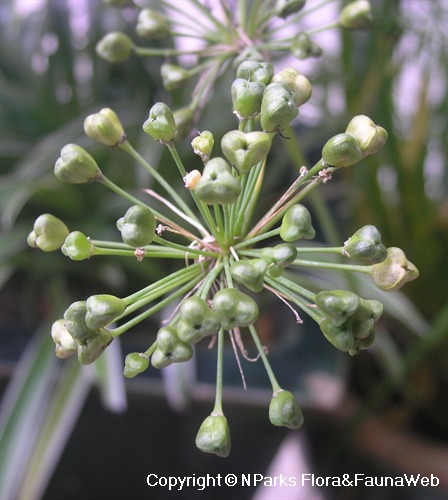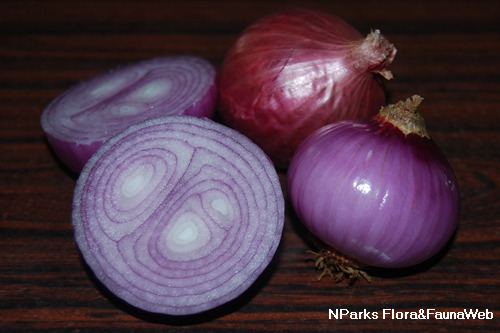
Back
Allium tuberosum Rottler ex Spreng.
| Family Name: | Amaryllidaceae |
| Synonyms: | Allium argyi, Allium roxburghii, Allium tricoccum, Allium uliginosum, Allium clarkei |
| Common Name: | Garlic Chives, Chinese Leeks, Chinese Chives, Flat Chives, Oriental Garlic, 韭菜 |
Name
Classifications and Characteristics
| Plant Division | Angiosperms (Flowering Seed Plants) (Monocotyledon) |
|---|---|
| Plant Growth Form | Herbaceous Plant |
| Lifespan (in Singapore) | Perennial |
| Mode of Nutrition | Autotrophic |
| Maximum Height | 0.4 m to 0.6 m |
| Maximum Plant Spread / Crown Width | 0.3 m to 0.6 m |
Biogeography
| Native Distribution | SW China, Southeast Asia |
|---|---|
| Native Habitat | Terrestrial (Disturbed Area / Open Ground) |
| Preferred Climate Zone | Tropical |
Description and Ethnobotany
| Growth Form | Perennial herb with a grass-like growth habit. |
|---|---|
| Foliage | Leaves green or grayish-green, flat, linear and pointed (0.3 - 0.4 m long and 0.5 -1 cm wide). Leaves have parallel venation. Leaves tend to bend over rather than remain erect. |
| Flowers | Flowers white or creamy white, bisexual and star-shaped. Sepals look like petals. Flowers arranged in an inflorescence known as a rounded umbel (5 - 7 cm wide). Floral stalks grow to a height of 0.3 - 0.6 m. Flowers produce a fragrance similar to that of violets. |
| Fruit | Fruits are capsules, initially dark green and becoming beige and papery at maturity. Each capsule contains 3 black seeds. Seeds are ovate, rounded at the base and pointed at the tip (4 mm long, 3 mm wide at the base). |
| Habitat | In Illinois (USA), it was observed to naturalize in a meadow and along the edge of a ditch. In some areas in Europe and North America, it is considered an invasive weed. |
| Cultivation | Plant in well-drained, fertile, loamy soil (pH = 5 - 8). Individuals should be spaced 7 - 15 cm apart. To prevent excessive spread of the plant, remove the inflorescence before it sets seed. It will grow well in the same location without replanting for several years. It is resistant to pests and diseases. However, the plant is susceptible to fungal diseases when planted in waterlogged soils or dense populations. Propagate by seed or by dividing the rootball. Plants should be divided every 3 - 4 years due to its fast growth. |
| Etymology | The genus name “Allium” is Latin for garlic. The species epithet “tuberosum” is a reference to this species's thick rhizome. |
| Ethnobotanical Uses | Edible Plant Parts : Edible Leaves, Edible Flowers, Edible Stems Food (Herb or Spice): Flowers, flower stalks, leaves and bulbs are all edible. Leaves of garlic chives may be consumed raw in salads or added to stir-fries, soups and dishes with egg or fish. It has a sweet flavor that is similar to garlic. Garlic chives contain many nutrients and minerals, such as vitamin C, carotene, calcium and iron. Medicinal: Garlic chives are used in Chinese traditional medicine to cure people who suffer from fatigue or have been poisoned. Leaves and bulbs are used to heal cuts and wounds, as they are thought to reduce bleeding. Others: The plant is thought to repel insects and moles. |
Landscaping Features
| Landscaping | Sometimes used in flowerbeds for its ornamental flowers. Also used along the edges of paths and gardens or as a groundcover. |
|---|---|
| Desirable Plant Features | Fragrant (Foliage) |
| Landscape Uses | Flowerbed / Border, Container Planting |
| Thematic Landscaping | Fragrant / Aromatherapy Garden, Economic Garden, Naturalistic Garden |
| Usage Hazard - Cons | Invasive / Potentially Invasive |
Fauna, Pollination and Dispersal
| Fauna Pollination Dispersal Associated Fauna | Butterfly-Attracting |
|---|---|
| Pollination Method(s) | Biotic (Fauna) (Insects (Butterfly, Moth)) |
| Seed or Spore Dispersal | Abiotic (Gravity) |
Plant Care and Propagation
| Light Preference | Full Sun, Semi-Shade |
|---|---|
| Water Preference | Moderate Water |
| Plant Growth Rate | Fast |
| Rootzone Tolerance | Drought Tolerant, Fertile Loamy Soils, Well-Drained Soils, Disease / Pest Resistant, Shallow Media |
| Maintenance Requirements | Low |
| Propagation Method | Seed, Division |
Foliar
| Mature Foliage Colour(s) | Green |
|---|---|
| Mature Foliage Texture(s) | Smooth |
| Foliar Type | Simple / Unifoliate |
| Foliar Shape(s) | Non-Palm Foliage (Linear) |
| Foliar Venation | Parallel |
| Foliar Margin | Entire |
| Foliar Apex - Tip | Acute |
| Foliar Base | Truncate / Square |
| Typical Foliar Area | Notophyll ( 20.25cm2 - 45 cm2 ) |
Non - Foliar and Storage
| Stem Type & Modification | Herbaceous |
|---|---|
| Root Type | Underground (Fibrous Root) |
Floral (Angiosperm)
| Flower & Plant Sexuality | Bisexual Flowers |
| Flower Colour(s) | Cream / Off-White, White |
|---|---|
| Flower Symmetry | Radial |
| Individual Flower Shape | Stellate / Star-shaped |
| Inflorescence Type | Umbel |
Fruit, Seed and Spore
| Mature Fruit Colour(s) | Brown |
|---|---|
| Fruit Classification | Simple Fruit |
| Fruit Type | Dehiscent Dry Fruit , Capsule |
Image Repository
Others
| Master ID | 30638 |
|---|---|
| Species ID | 4947 |
| Flora Disclaimer | The information in this website has been compiled from reliable sources, such as reference works on medicinal plants. It is not a substitute for medical advice or treatment and NParks does not purport to provide any medical advice. Readers should always consult his/her physician before using or consuming a plant for medicinal purposes. |


















